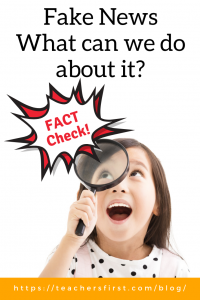80% of middle schoolers mistake sponsored content for real news
3 in 4 students can’t distinguish between real and fake news on Facebook
Fewer than 1 in 3 students are skeptical of biased news sources
 As educators, what can we do to make sure our students are not counted as one of the statistics surrounding fake news? From librarians to news organizations to educational associations, help for educators to combat fake news in their classrooms is at an all-time high. There are many strategies to choose from.
As educators, what can we do to make sure our students are not counted as one of the statistics surrounding fake news? From librarians to news organizations to educational associations, help for educators to combat fake news in their classrooms is at an all-time high. There are many strategies to choose from.
The best strategy is teaching students the skills they need to be their own fact checkers. There are a variety of lessons plans available for all types of classrooms. Students in elementary school need to be able to start distinguishing fact from opinion. In middle school, students can begin to learn what is considered news and how media affects so many aspects of our lives. There are many lessons available for grades 3-8 on CommonSense Media through their digital citizenship curriculum. Once they are in high school, students need to be able to start identifying fake news and critically analyzing media.
There are many online games and activities available for classroom use. The New York Times offers a variety of classroom-ready activities like distinguishing between fact and opinion, what’s going on in this picture, and the weekly news quiz. Games like Factitious and Fake it to Make It are all about recognizing fake news. Assess students’ skills in recognizing fake news by trying out a quiz by Penguin Books, Channel One News (Houghton Mifflin Harcourt), the BBC, or Politifact. Find a mix of online activities at Flackcheck.org from Annenberg Public Policy Center.
We should also strive to make sure that students have resources that they need readily available to them to help them evaluate various types of media. For younger students, Kathy Schrock’s 5Ws of website evaluation is in plain language and easily understandable. For older students, the CRAAP test and RADAR are more appropriate. Students should also have access to fact-checking sites like Factcheck.org, the Washington Post Fact Checker, Snopes, and Politifact.
Teachers need resources too! For teacher use, check out Web Literacy for Student Fact-Checkers …and other people who care about facts and PACE University’s Real vs. Fake News libguide. Be on the lookout for the upcoming digital literacy project MediaWise for teens. As always, TeachersFirst also has resources for you. Check out our media literacy page and our related blog posts. Let’s make sure to work together to make our students accomplished fact checkers!

